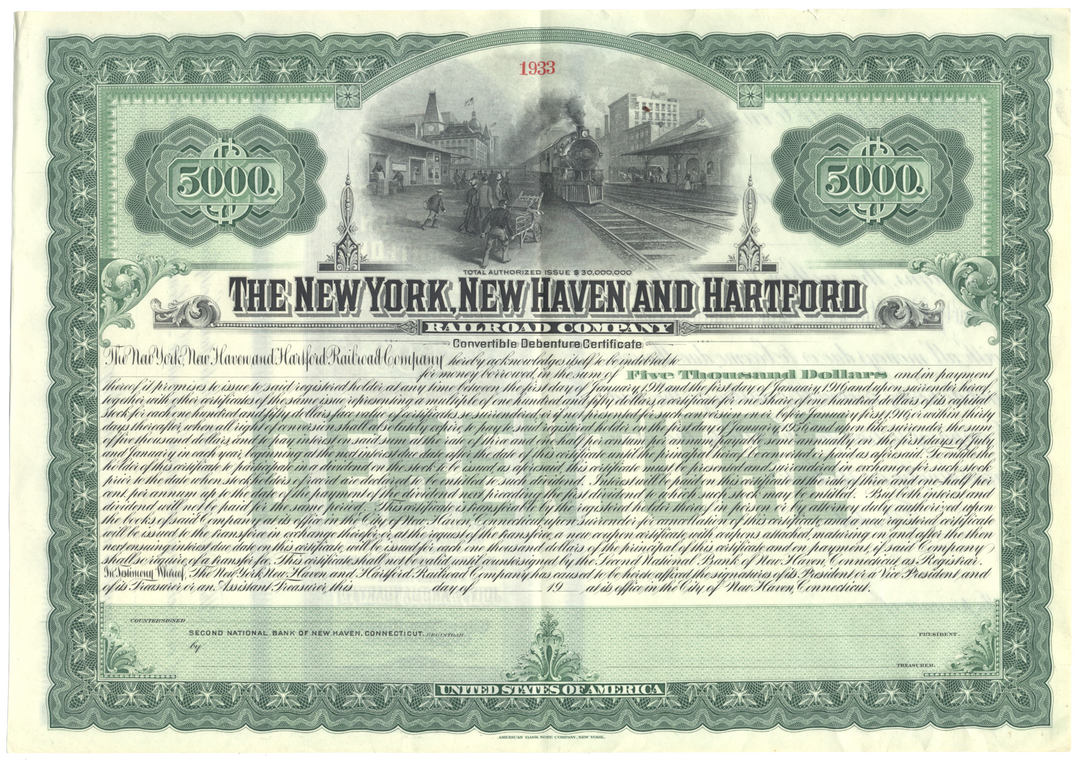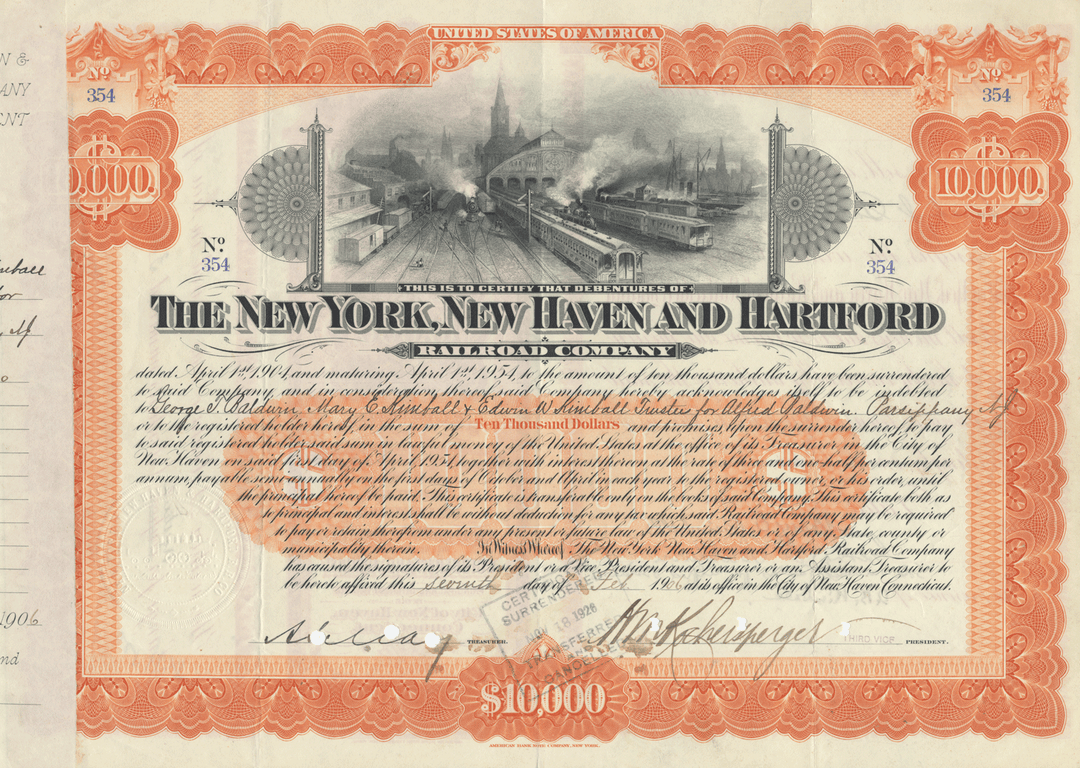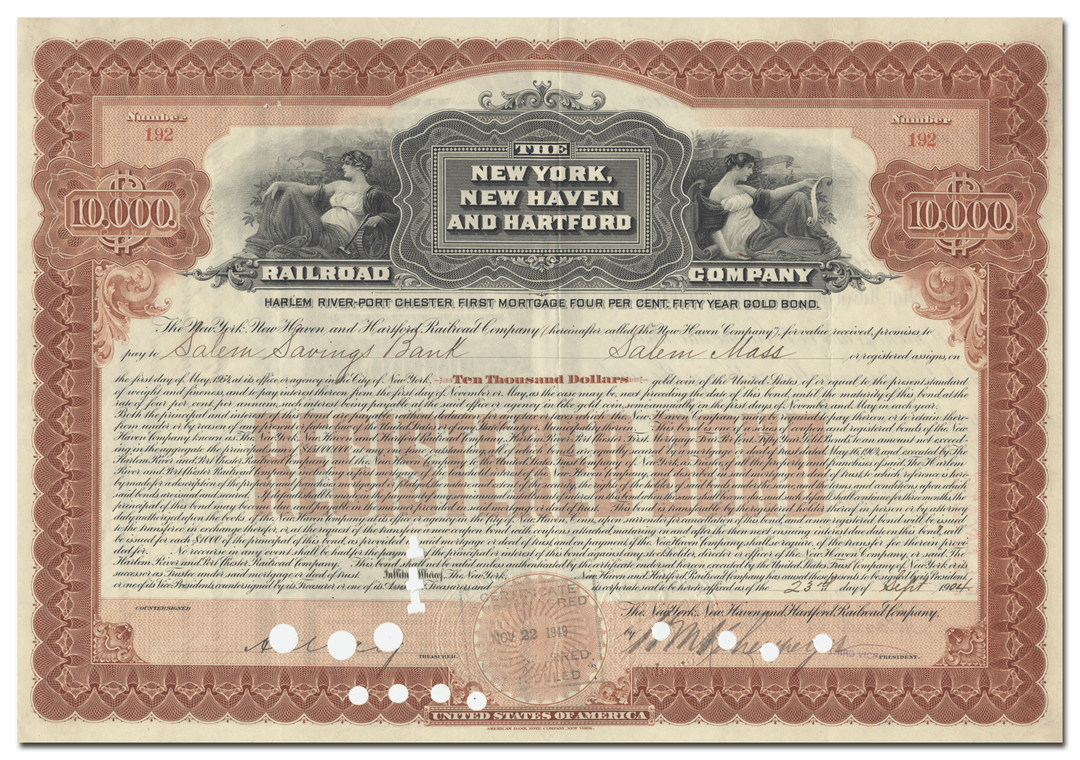
The New York, New Haven and Hartford Railroad operated in the northeast United States from 1872 to 1969. Commonly referred to as the New Haven, the railroad served the states of Connecticut, New York, Rhode Island, and Massachusetts. Its primary connections included Boston and New York City.
The New York, New Haven and Hartford Railroad was formed July 24, 1872 through the consolidation of the New York and New Haven Railroad and Hartford and New Haven Railroad. It owned a main line from New York City to Springfield, Massachusetts via New Haven and Hartford, Connecticut, and leased other lines, including the Shore Line Railway to New London. The New Haven went on to lease more lines and systems, eventually forming a virtual monopoly in New England south of the Boston and Albany Railroad.
A parallel branch line was extended from Oakfield to Ashland in 1896. A branch was built from Caribou to Limestone in 1897, and the main line extended from Caribou to Van Buren in 1899. The Ashland Branch was extended to Fort Kent in 1902. A southern extension was completed in 1905 through Northern Maine Junction to Searsport on Penobscot Bay. The Medford Cutoff from Packard to South Lagrange was completed in 1907, and a branch was built from Millinocket to a new paper mill in East Millinocket. Rails were extended up the Maine side of the Saint John River from Van Buren through Madawaska and Fort Kent to St. Francis in 1910; and Mapleton was connected to Stockholm and Presque Isle on the main line, and to Squa Pan on the Ashland branch. An international bridge was constructed over the Saint John River between Van Buren and St. Leonard, NB in 1915 to connect with the Canadian Pacific Railway and National Transcontinental Railway (later merged into the Canadian National Railway).
Potatoes provided a stable income source through the great depression, and provided 50% of the railroad's revenue following World War II. BAR had the second-largest United States railroad-owned reefer fleet (after Santa Fe) during the 1950s. BAR made an arrangement with Pacific Fruit Express whereby PFE reefers shipped Maine potatoes during winter months and BAR reefers carried California produce during the summer and autumn. While potatoes started moving by truck following completion of the Interstate Highway System into northern Maine in the 1960s, what actually resulted in the railroad losing its potato business forever was the Penn Central Transportation Company (PC), whose interchange service became so bad during the winter of 1969–70 that a large portion of the 1969 potato crop was spoiled by freezing when car heaters ran out of fuel. The claims process against PC was not resolved prior to PC's bankruptcy declaration the following June. As a result, several potato farms went out of business; those that survived distrusted rail service and never returned to using the railroad.
Inbound chemicals and outbound paper from mills on the Penobscot River at Millinocket and East Millinocket were major revenue sources for the BAR from 1900. Another paper mill was built in Madawaska in 1925. Pulpwood and wood chip shipment to the paper mills became increasingly important as potato loadings declined. The remote port facilities at Searsport were a preferred loading point for ammunition during World War II, and BAR transported heating coal and aircraft fuel to Loring AFB for Strategic Air Command bombers through the Cold War. BAR painted 2,500 boxcars in the red, white and blue colors of the US flag during the 1950s. A less-expensive oxide red paint scheme with large white reporting marks was adopted during the Vietnam War.
The line from Brownville Junction to Katahdin Iron Works was abandoned in 1922, but the rails remained in place until 1933.
The first line of the original system to open was the Hartford and New Haven Railroad, opened from New Haven to Hartford in 1839 and beyond to Springfield in 1844. The New York and New Haven came later, as it ran parallel to the Long Island Sound coast and required many bridges over rivers. It opened in 1848, using trackage rights over the New York and Harlem Railroad (later part of the New York Central Railroad system) from Woodlawn south to Grand Central Terminal, which served as the New Haven's New York City terminal.
Around the turn of the century, New York investors, led by J. P. Morgan gained control and in 1903, installed Charles S. Mellen as President. Morgan and Mellen sought a complete monopoly of transportation in New England, purchasing other railroad and steamship and trolley lines. More than 100 independent railroads eventually became part of the system before and during these years, reaching 2,131 miles at its 1929 peak. Substantial improvements to the system were made during the Mellen years, including electrification between New York and New Haven. But Morgan's expansion left the company overextended and financially weak.
Under the stress of the Great Depression, in 1935 the New Haven slipped into bankruptcy, remaining in trusteeship until 1947. Common stock was voided and creditors assumed control.
After 1951 both freight and passenger service lost money. New Haven's earlier expansion had left it with a network of light density branch lines that could not support their maintenance and operating costs. The New Haven's freight business was short-haul, requiring a lot of switching costs that could not be recovered in short-distance rates. The New Haven had major commuter train services in New York and Boston (as well as New Haven, Hartford and Providence), but these always lost money, unable to recover their investment providing service just twice a day during rush hour. The death of the New Haven may have been sealed by the building of the Connecticut Turnpike and other interstates. With decades of inadequate investment, the New Haven could not compete against the automobile or the trucker.
In 1954 the flashy Patrick B. McGinnis led a proxy fight against incumbent president Frederic C. "Buck" Dumaine Jr., vowing to return more of the company's profit to shareholders. McGinnis accomplished this by deferring maintenance. McGinnis also spent money on a flashy new image for the company - green and gold trim was replaced by black, red-orange and white. When he departed, 22 months later, he left the company financially wrecked, a situation exacerbated by widespread hurricane damage in 1955. In 1959, the New Haven discontinued passenger service on the Old Colony network in southeastern Massachusetts. Despite this and other cutbacks, the New Haven once again went into bankruptcy on July 2, 1961.
At the insistence of the ICC, the New Haven was merged with Penn Central on January 1, 1969, ending rail operations by the corporation. The corporate entity would remain in existence throughout the 1970s as the Trustee of the Estate pursued just payment from Penn Central for the New Haven's assets.
On August 28, 1980 American Financial Enterprises, Inc., became the successor to the New York, New Haven and Hartford Railroad Company when the plan for reorganization was approved by the court and the company was reorganized. This brought to an end the 108 year corporate history of the storied railroad, and the end to the 19 year saga of its second bankruptcy reorganization. Ironically, American Financial Enterprises would become the largest single stockholder of Penn Central Company shares by the mid-1990s controlling 32% of the stock of the company.
Following the bankruptcy of Penn Central, in 1976 a substantial portion of the former New Haven main line between New York and Boston was transferred to Amtrak, and now forms a major portion of the electrified Northeast Corridor, hosting high speed Acela Express and commuter rail service.
Harlem River and Port Chester Railroad
The Harlem River and Port Chester Railroad was the New Haven's first lease after its merger. It was chartered in 1866, leased by the New Haven on October 1, 1873, and opened later that year, running from the New Haven at New Rochelle, New York south into the Bronx, New York City. It was originally a branch line, but in 1916 the New York Connecting Railroad and its Hell Gate Bridge opened, turning the Harlem River Branch into a major through route.
New York, Westchester & Boston Railroad
The New York, Westchester & Boston was a subsidiary of the New Haven that began regular operation in 1912. It operated a heavy multi-track electric railroad between Harlem River terminal in the Bronx and White Plains, New York, along with a branch to Port Chester, New York, part of which paralleled the NH mainline from Larchmont. Built to the highest standards of construction, the railroad was a constant money-loser and served an under-developed population. Operations ceased on December 31, 1937, and the railroad was dismantled for scrap.
The "Westchester" still survives today in the Bronx, as the southern portion of the line, running from Dyre Ave to East 180th Street, was purchased by the City of New York to offer subway riders in this residential area a direct link to Manhattan. Because the IRT subway cars used on this line are narrower than standard railroad cars, platforms on the IRT Dyre Avenue Line had to be modified to use the smaller subway cars. The 5 line runs express via Lexington Ave (except late nights), or riders can change at East 180th street for the 2 line, which runs down Broadway on the west side on Manhattan. Formerly, Westchester riders would change at 180th street and walk over a causeway from the RR station to the IRT elevated structure. The lack of a direct route to downtown Manhattan was a major reason for the Westchester's demise.
New Haven, Middletown and Willimantic Railroad
The New Haven, Middletown and Willimantic Railroad opened in 1873 as part of the Boston, Hartford and Erie Railroad system, running from New Haven northeast via Middletown to the BH&E at Willimantic. The BH&E went bankrupt that same year, becoming the New York and New England Railroad, but the NHM&W stayed separate, failing in 1875. It was reorganized as the Boston and New York Air-Line Railroad, and operated by the New Haven from 1879, being leased on October 1, 1882.
Hartford and Connecticut Valley Railroad
The New Haven obtained a majority of stock of the Hartford and Connecticut Valley Railroad in 1882, running from Hartford south and southeast to the Shore Line Railway in Old Saybrook via Middletown. That line had originally opened in 1871 as the Connecticut Valley Railroad, and continued north to Springfield, Massachusetts via the Connecticut Central Railroad, later part of the New York and New England Railroad system. Later, the company was succeeded by the Hartford and Connecticut Valley.
Naugatuck Railroad
The New Haven leased the Naugatuck Railroad on April 1, 1887, obtaining a line from Naugatuck Junction on the New York-New Haven line near Stratford north via Waterbury, reaching the Central New England Railway at Winsted. The line, organized in 1848, had opened in 1849.
New Haven and Northampton Railroad
The New Haven and Northampton Railroad, built next to the former Farmington Canal, ran from New Haven north to Northampton, Massachusetts and beyond to the Fitchburg Railroad's Troy and Greenfield Railroad. The New York and New Haven Railroad leased the first few sections soon after they opened, obtaining the line to Plainville in 1848 and the extension to Granby plus several branches two years later. In 1869 the leases expired, and the railroad was independent until April 1, 1887 when the New Haven leased the whole line.
New York, Providence and Boston Railroad
The New York, Providence and Boston Railroad was a continuation of the Shore Line Railway past New London to Providence, Rhode Island. The line was incorporated in 1832 and opened in 1837. The New Haven leased it in 1892, merging it into itself on February 13, 1893.
Housatonic Railroad
The Housatonic Railroad, chartered 1836 and opened 1842 (with branches opening later), had a line from the New Haven in Bridgeport north, passing east of Danbury, to West Stockbridge, Massachusetts (later the Boston and Albany Railroad in Pittsfield). The Housatonic leased the Danbury and Norwalk Railroad (opened 1852), running from Danbury (to which the Housatonic had a branch) south to Norwalk on the New Haven, in 1887, and it leased the New Haven and Derby Railroad (opened 1871-1888), a branch to New Haven, in 1889. On July 1, 1892 the New Haven leased the Housatonic, giving the New Haven all the north-south lines in western Connecticut.
Providence and Worcester Railroad
The Providence and Worcester Railroad was also leased and-on July 1, 1892, running from Providence, Rhode Island northwest to Worcester, Massachusetts. It was incorporated in 1844 and opened in 1847.
Old Colony Railroad
The New Haven leased the massive Old Colony Railroad system on March 1, 1893, spanning all of southeastern Massachusetts and completing the route to Boston via the Old Colony's Boston and Providence Railroad. The original mainline opened in 1845; the Boston and Providence (leased 1888) opened in 1834 and 1835.
New England Railroad
The New England Railroad was the final link in a long chain of reorganizations of a network usually known by its prior name, the New York and New England Railroad. It stretched mainly east-west across central Connecticut, connecting to the Hudson River on the west and to Providence and Boston on the east. The New Haven leased the company on July 1, 1898. The first sections opened in 1849 as parts of the Norfolk County Railroad and Hartford, Providence and Fishkill Railroad, and construction progressed very slowly.
Shepaug, Litchfield and Northern Railroad
The New Haven also leased the Shepaug, Litchfield and Northern Railroad on July 1, 1898, running north from Danbury, Connecticut to a dead end at Litchfield. It was chartered in 1868 and opened in 1872 as the Shepaug Valley Railroad, becoming the Shepaug Railroad in 1873 and the SL&N in 1887.
Middletown, Meriden and Waterbury Railroad
The Middletown, Meriden and Waterbury Railroad was the final name of the line from Waterbury, Connecticut east to Cromwell, on the Connecticut River north of Middletown. The New York and New England Railroad leased the line (then the Meriden, Waterbury and Connecticut River Railroad) in 1892 (connecting in Waterbury), but the MW&CR went bankrupt soon after, and was reorganized as the MM&W in October 1898 and immediately leased to the New Haven on November 1, 1898. This line was the first in the area to be abandoned, only running interurban streetcar service in its final days. The MW&C had been formed in 1888 as a consolidation of the Meriden and Cromwell Railroad (opened 1885) and Meriden and Waterbury Railroad (opened 1888).
Central New England Railway
The Central New England Railway was the New Haven's final acquisition in 1904. It included the Poughkeepsie Bridge, the southernmost fixed crossing of the Hudson River from 1888 to 1916 (when the Hell Gate Bridge opened), with its main line stretching east to Hartford and Springfield. The first section opened in 1871 as the Connecticut Western Railroad, going through several reorganizations before its final state.
New York Connecting Railroad
The New York Connecting Railroad was incorporated in 1892, opening in 1916 as a connection between the New Haven's Harlem River and Port Chester Railroad and the Pennsylvania Railroad's Pennsylvania Tunnel and Terminal Railroad to Penn Station and the tunnels under the Hudson River. It was owned half-and-half by the New Haven and Pennsylvania.




































































